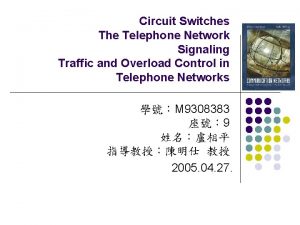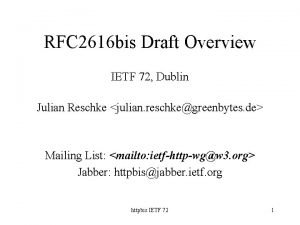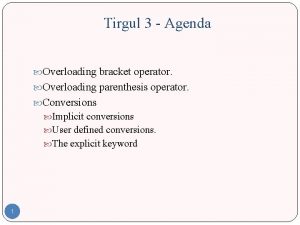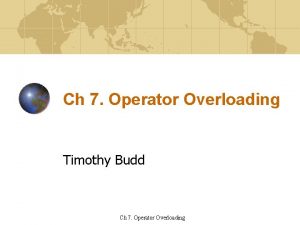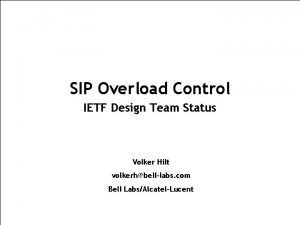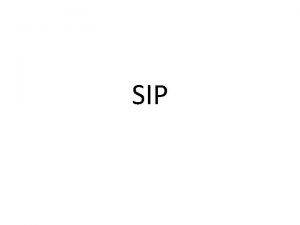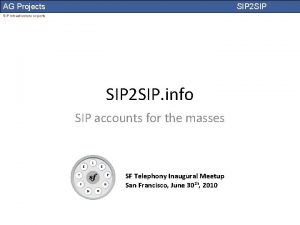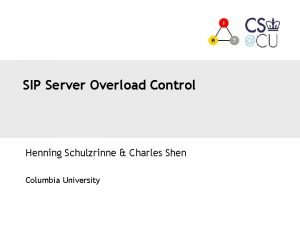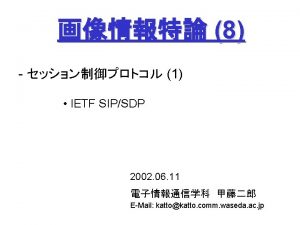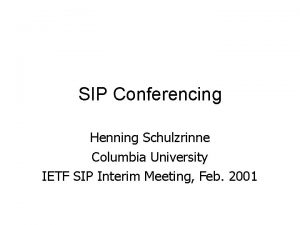SIP Overload Control Report from the IETF Design














- Slides: 14

SIP Overload Control Report from the IETF Design Team Volker Hilt volkerh@bell-labs. com Bell-Labs/Alcatel-Lucent All Rights Reserved © Alcatel-Lucent 2006, #####

Overview IETF SIP Overload Control Design Team Simulation Results for SIP Overload Control Conclusion 2

IETF SIP Overload Control Design Team was founded beginning of 2007 by SIPPING WG Members § Eric Noel, Carolyn Johnson (AT&T Labs) § Volker Hilt, Indra Widjaja (Bell-Labs/Alcatel Lucent) § Charles Shen, Henning Schulzrinne (Columbia University) § Ping Wu*, Tadeusz Drwiega*, Mary Barnes (Nortel) § Jonathan Rosenberg (Cisco) § Nick Stewart (British Telecom) Developed four independent simulation tools § AT&T, Bell-Labs, Columbia, Nortel* § Simulation results for SIP § Proposals and initial results for overload controlled SIP. * Left design team in fall 2007 3

Simulation Results Setup and Assumptions SIP server topology consisting of UAs, edge proxies and core proxies. UAs are connected to edge proxies. § Each UA creates a single call (INVITE followed by BYE transaction). § Poisson arrival rate. § Load is equally distributed across edge proxies. Edge proxies forward requests to a core proxies. § Edge proxies reject a request if one/both core proxies are overloaded. § To break up the problem domain we assume edge proxies have infinite capacity. Core proxies forward call to the edge proxy of the destination. § Capacity: 500 messages per second at a constant rate. Server Topology All proxies are modeled as queuing system. § Queue size: 500 messages Media path congestion is not considered. 4 Proxy Model

Simulation Results Client-to-Server vs. Server-to-Server Communication A server sends a stream of SIP requests to other servers. SIP request streams between servers are dynamic. § Load between servers can be reduced gradually by rejecting/retrying some of the requests. Overload control can use feedback to request that an upstream server reduces traffic to a desired amount. Client-to-Server Communication UAs typically only initiate a single request at a time. § A UA can be told to wait a certain time before resending the request. Feedback-based overload control does not prevent overload in the server. 5 B D C Server-to-Server Communication a b c D … Problem: a large number of UAs can cause overload even if all UAs are told to back-up. A z UA-to-Server Communication

Simulation Results Scenario 1: No Overload Control Assumptions Proxies do not use any overload control. When the input buffer of a proxy is filled up, messages are dropped. Requests that failed at one of the core proxies are not retried. Results The number of INVITE transactions completed (i. e. , calls set up) drops to zero. Congestion collapse! 6

Simulation Results Scenario 2: 503 (Service Unavailable) – Reject Requests Assumptions Proxies use 503 (Service Unavailable) responses to reject requests during overload. Watermark-based (Bang-Bang) overload control algorithm: § Enter overload state when queue length reaches high watermark (400 messages) § Enter normal state when queue length drops below watermark (300 messages) § When in overload state a proxy rejects all incoming requests with 503 responses. Edge proxies do not retry requests that are rejected. Results Provides little or no improvement compared to no overload control. § Note: Performance can be improved by using other control algorithms. Congestion collapse! 7

Simulation Results Scenario 3: 503 (Service Unavailable) - Retry Requests Assumptions Same assumptions as in Scenario 2. But: edge proxies retry all requests that have been rejected by one core proxy at the second core proxy. § Requests are rejected only if they fail at both core proxies. Results Retrying requests decreases goodput. § Increased load caused by retries. Congestion collapse! 8

SIP Overload Control Mechanisms and Algorithms The IETF SIP overload design team has started to investigate solutions for more effective SIP overload control mechanisms. Current simulations of SIP overload control mechanisms are focusing on: § Server-to-server communication. § Feedback channel between core and edge proxy (hop-by-hop). § Four different overload control mechanisms: on/off control, rate-based control, loss-based control, window-based control. Simulation results available for these four mechanisms and different control algorithm proposals. § Contributed by AT&T Labs, Bell-Labs/Alcatel-Lucent, Columbia University § Initial simulation results. 9

SIP Overload Control Hop-by-hop vs. end-to-end SIP requests for the same source/destination pair can travel along different paths, depending on § provider policies, services invoked, forwarding rules, request forking, load balancing, etc. A SIP proxy cannot make assumptions about which downstream proxies will be on the path of a SIP request. C A B D Hop-by-hop overload control § Server provides overload control feedback to its direct upstream neighbor. Hop-by-hop No knowledge about routing policies of neighbors needed. § Neighbor processes feedback and rejects/retries excess requests if needed. x End-to-end overload control § Feedback from all servers on all paths between a source and a destination needs to be considered. A server needs to track the load of all servers a request may traverse on its way to the target. C A B § Complex and challenging since requests for the same destination may travel along very different paths. May be applicable in limited, tightly controlled environments. 10 D x End-to-end

SIP Overload Control AT&T Labs Simulation Results § Every sampling interval, Core Proxies estimate optimal control parameters such that queueing delay is within a pre-defined target delay. Core Proxies solely rely on measured offered load and measured internal queueing delay (no Edge Proxies to Core Proxies signaling). § On/off control builds upon existing SIP 503 Retry-After capability. Each control interval, Core Proxies estimate optimal retry after timer value and share with Edge Proxies within the 503 messages. § In rate-based control, each control interval, Core Proxies estimate optimal controlled load and active sources, then share with Edge Proxies either with dedicated signaling or as overhead in response messages. Edge Proxies execute percent blocking throttling algorithm. 11

SIP Overload Control Bell-Labs/Alcatel-Lucent Simulation Results Loss-based overload control. Feedback-loop between receiver (core proxy) and sender (edge proxy). § Feedback in SIP responses. Receiver driven control algorithm. § Estimates current processor utilization. § Compares to target processor utilization. § Multiplicative increase and decrease of loss-rate to reach target utilization. Sender adjusts the load it sends to receiver based on the feedback received using percent-blocking. Overload control algorithms: § Occupancy algorithm (OCC), Acceptance Rate/Occupancy algorithm (ARO) 12

SIP Overload Control Columbia University Simulation Results § Window-based overload control § SIP session as control unit, dynamically estimated from processed SIP messages § Receiver (Core Proxy in the scenario) decreases window on session arrival dynamically computes available window splits and feedbacks to active Senders Feedback piggybacked in responses/requests § Sender (Edge Proxy in the scenario) forwards a session only if window slot available § Three different window adaptation algorithms work equally well in steady state CU-WIN-I: keep current estimated sessions below total allowed sessions given target delay CU-WIN-II: open up the window after a new session is processed CU-WIN-III: discrete version of CU-WIN-I, divided into control intervals 13

Conclusion Current Status The SIP protocol is vulnerable to congestion collapse under overload. § The 503 response mechanism is insufficient to avoid congestion collapse. § Simulation results confirm problems. The IETF design team is investigating different mechanisms and algorithms for SIP overload control. § Initial simulation results are available. § Results show stable server-to-server goodput under overload. Open Issues § Overload control with uneven distribution of load and fluctuating load conditions. § Dynamic arrival and departure of servers. § Fairness between upstream neighbors. Comments and suggestions are very welcome! 14
 Spc switching system overload control
Spc switching system overload control Ietf rfc 2616
Ietf rfc 2616 Ietf mud
Ietf mud What is principles of individuality
What is principles of individuality C++ parenthesis operator
C++ parenthesis operator Hukum fisiologik
Hukum fisiologik Rpe scale 1 10
Rpe scale 1 10 Series hydraulic circuit
Series hydraulic circuit Environmental psychology definition
Environmental psychology definition Overload symbol
Overload symbol Principles of training
Principles of training Contactor coil symbol
Contactor coil symbol Determinants of prosocial behaviour
Determinants of prosocial behaviour C++ overload arrow operator
C++ overload arrow operator Simbol thermal overload relay
Simbol thermal overload relay
